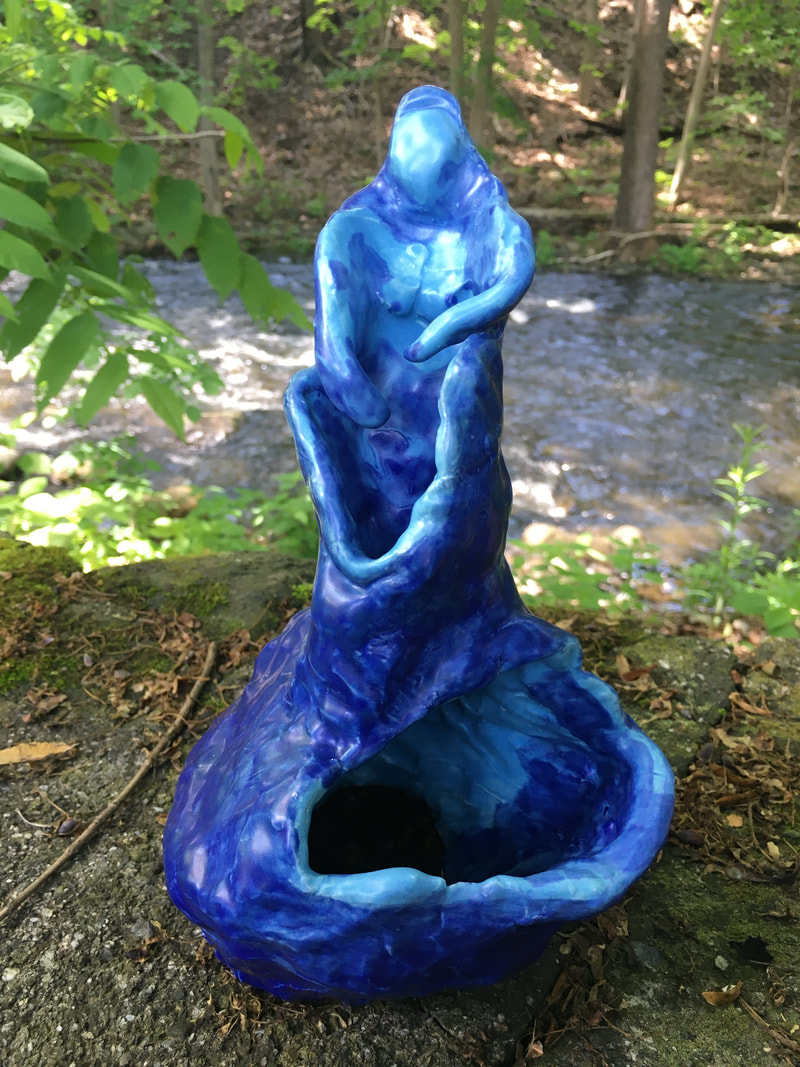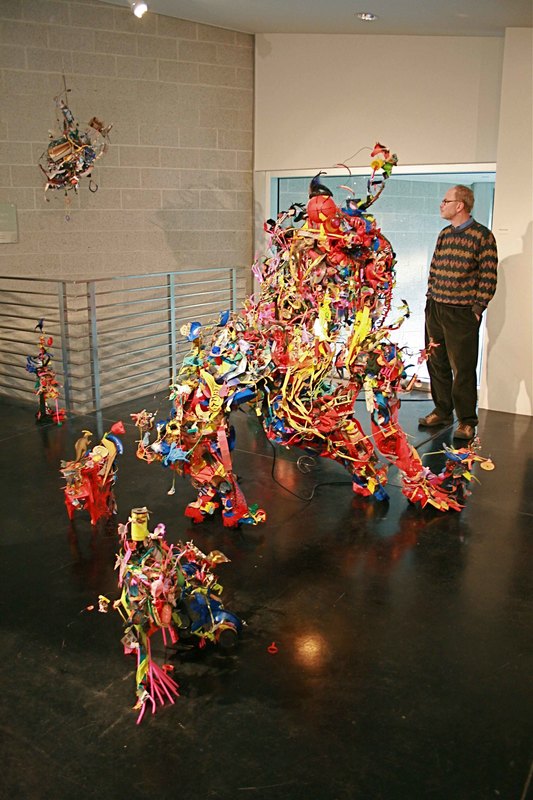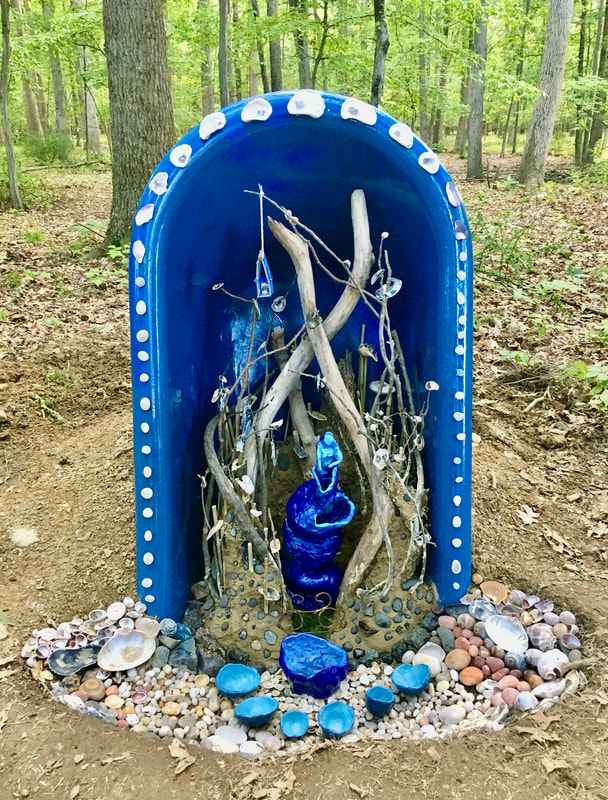
Bathtub Grotto, 2021, 4 ft x 3.5 ft x 3 ft,
Repurposed bathtub, wattle and daub, clay, sand, stone, shells, branches, moss, glass, lace, twine, ceramic, glaze,
Description:
The sculpture investigates the history of grotto sanctuaries, folk Catholic yard structures in the United States juxtaposed with elements of off-grid earth-based design to reclaim a sacred imagination of reciprocity and its essential relationship to earth.

Capitalist Vampire Bat Exterminator, 2020, wire, wood, hand-sewn fabric, acrylic, buttons, 33” h x 95” w x 40” d, Created for The Wassaic Project Haunted Parade in collaboration with Christopher Santiago. This vampire bat was created in the image of a real vampire bat to fight the vampire thirst of capitalism, an image Karl Marx uses, to describe the corruption of wealth. The bat also alludes to epidemic/pandemic sources and our poor industrial relationship with animal food systems. Fabric was sourced from my personal clothing. The fox was a woodland assistant to the exterminator bat.
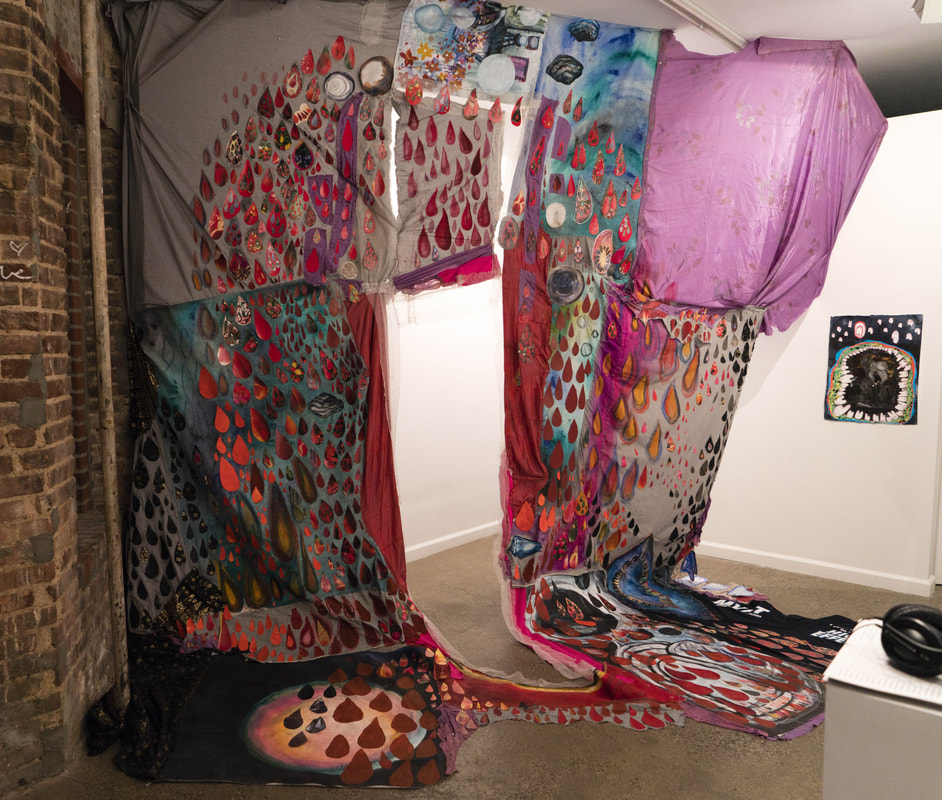
Hibernacula, 2017, hand-sewn canvas, fabric, acrylic, collage, 156 x 133 x 1 inches,
Viewers are able to enter the work through the opening of the fabric wall hanging sculpture that serves as the threshold. It can be rolled up and reassembled to fit different spaces. This installation of the piece is from Equity Gallery in New York, NY.
The tooth is one of the first parts of the body that are lost. It is one of the first instances in which children universally deal with loss as a concept. This loss is particularly a lost part of their selves that becomes debased. After repeatedly drawing and cutting out the form of the tooth, this shape shifted and became the smoother simpler form of the drop. Water, tear, blood (menstrual), salvia, are all relevant associations evoked from the dominant red, black, and blue paper, fabric, and paint drops that cover my installation, Hibernacula. This form emerged from personal mourning/cleansing from a significant loss. Continuing on the idea of bodily extension that the tooth operates in, I realized that the droplet symbol was more emotionally pertinent for me due to its watery and versatile nature. I found it necessary to fill my installation with this shape, especially the entering threshold zones of the hanging fabric.
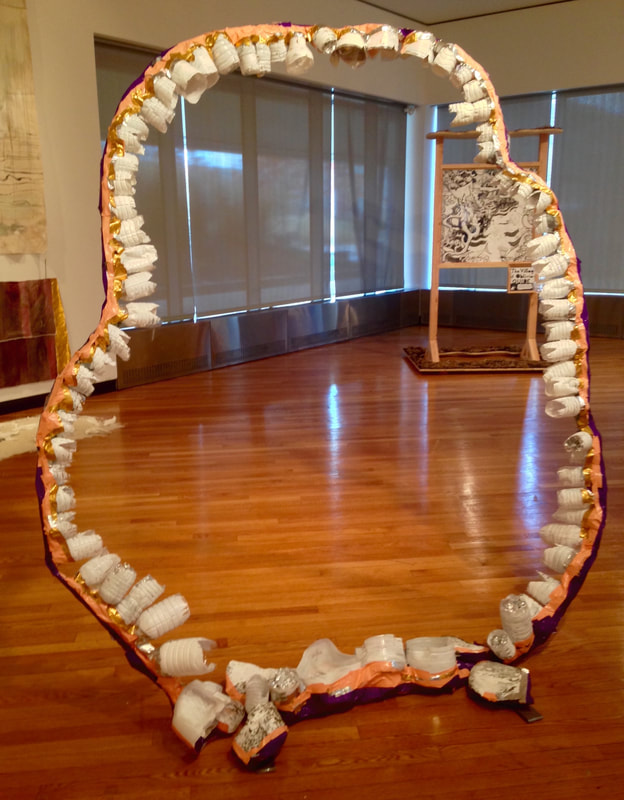
Molars are Made for Grinding, 2016, plastic bottles, duct tape, acrylic, iron rod, rocks, 66 x 84 x 4 inches,
The idea of the vagina dentata illustrates a threat to patriarchal power. Molars are Made for Grinding (2016) is a surreal sculpture of a mouth about 7 ft high, 5 ft wide, and 3 ft in diameter. This is a freestanding structure I built with a thin iron rod welded into a flat oval frame. This organic loop stands on the floor by iron stands weighted by rocks. Half cut plastic water bottles are attached by “flesh color,” purple, silver and gold duct tape to the frame. These serve as teeth. They are painted white and jut inward toward the open center. Its awkward tall flat form ominously sways and appears to breathe. It functions as both a frame and a passageway. Viewers can step through this massive mouth if they please. Reminiscent of a Coney Island or gypsy parade float, the sculpture suggests a humorous and celebratory evocation of the vagina dentata trope. I think comedy is useful to address and sooth our culture’s negative attitudes towards the female body. Organs that are the gateway to birthing life are particularly subject to aspersion, but even the clitoris was erased in the 25th edition of Grey’s Anatomy in 1948 and was not fully documented medically again until 1998, (Huffpost, 2014)! In my work, making the female reproductive orifice into a metaphorical place of chewing and entering paired with festivity acknowledges our feared relationship of this anatomy with devouring, but also play.

Labyrinth Talpidae, collaboration with Jan Rogalski, 2017, 25 ft diameter, stones, wood, In summer 2016, I collaborated with Jan Rogalski in building a 25-foot-diameter stone labyrinth during a residency at Eco Practicum in the Catskills. Different from a maze, which is meant to trick those who walk through it, a labyrinth is a winding path that functions to slow down the mind, rooting our awareness in the steps we take. A labyrinth is a spiraling passage that sends walkers into its center and then out on the same winding path. Just as permaculture—an agricultural design principle of sustainable growth—uses “companion planting” to optimize beneficiary living relationships, we intended our spiraling path to help people feel grounded. We felt that the labyrinth design would aide the relationship of human to earth.

Scarecrow: Protector for and against the In-between, the Unseen, repurposed clothing, special found objects, acrylic, wood, plaster, 71 IN x 36 IN x 13 IN, 2017
A note on Scarecrows: Halloween (a time when the veil is thinnest) was always my favorite holiday when I was a child, and each year I created elaborate scarecrows with my family to decorate our porch. I was pleased with the fact that as a sculpture it held space and as a scarecrow it-was human- looking enough to serve as an in-between, mediating the living and the artificial. I continued working with this form after Halloween passed. I now make stuffed scarecrow figures out of old clothing, newspaper, and string and embellish them with special objects such as charms people have given me for protection, like a bedazzled lizard pin. A festive activity from childhood translated into a new power in adulthood. Instead of warding off crows from crops, or celebrating a time of year, these soft sculptures have transformed into friends that protect me. My scarecrows serve as conduits between the seen and unseen. They are a physical space for the unformed spirit matter to be made tangible. In my opinion, building a being to stand on its own and literally and metaphorically hold a conversation with others is the purest definition of art. By making these assemblage humanoid forms, I affirm my belief in a protective presence that is summoned from the stuffing, wrapping, tying, and combining of salvaged materials. These repetitive processes work together to make habitation for a spirit.
